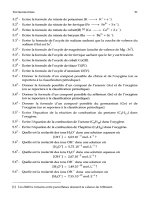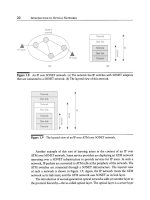Toxicology A Case-Oriented Approach - part 6 pdf
Bạn đang xem bản rút gọn của tài liệu. Xem và tải ngay bản đầy đủ của tài liệu tại đây (64.75 KB, 4 trang )
© 2002 by CRC Press LLC
TOXICITY OF SULFIDES
Hydrogen sulfide has two major toxic actions. The first is a depressant effect on the
CNS. A result of this effect is paralysis of the respiratory center and death. The second
is inhibition of cytochrome oxidase in a manner very similar to the effect of cyanide.
H
2
S is actually a more potent inhibitor of cytochrome oxidase than is cyanide.
Carbon disulfide has some toxic features in common with H
2
S. It attacks the
CNS and the cardiovascular system. However, it has its own uniquely toxic character
in causing a peripheral neuropathy with cranial nerve damage (see Chapter
10 on
neurotoxins). Curiously, it is also atherogenic in experimental animals.
THERAPY
The cyanide antidote kit is effective with H
2
S poisoning. The nitrites within the kit
convert hemoglobin to methemoglobin which becomes an agent for binding hydro
-
gen sulfide before it can bind cytochrome oxidase and cause death. Sulfmethemo-
globin is formed by the reaction between methemoglobin and either H
2
S or hydrogen
sulfide anion and this substance is excreted into the urine as such or as nontoxic
metabolites.
LABORATORY TESTING
Hydrogen sulfide is like cyanide in the sense that many victims will die too soon
for laboratory evaluation to be of any help. However, testing for sulfide ion in blood
may help to make the diagnosis for those who are less disabled. An ion-selective
electrode has been developed for measurement of sulfide ion. Because this electrode
is not completely specific to sulfide to the exclusion of all other ions, it is necessary
to pre-treat the specimen and isolate sulfide. This has been done, in one method,
with Conway microdiffusion cells. Concentrations of sulfide ion found in H
2
S deaths
ranged from 1.7 to 3.75
µg/mL.
HYDROCARBONS
By definition these are compounds which contain only carbon and hydrogen. Many
such compounds have been identified in the natural world, a good number of which
are found in crude oil. They include the aliphatic alkanes, alkenes, and alkynes,
which differ among each other in regard to the saturation of the carbon atoms. The
most common members of this class are methane, ethane, propane, and butane. All
members of this category are very abundant in the industrial world. The aromatic
hydrocarbons include benzene and the many compounds derived from benzene.
Halogenated hydrocarbons and organohalide insecticides are similar to hydro-
carbons in some chemical and toxicological properties; however, they also have
unique toxicological traits and will be discussed in a separate section of this text.
© 2002 by CRC Press LLC
TOXICITY OF SULFIDES
Hydrogen sulfide has two major toxic actions. The first is a depressant effect on the
CNS. A result of this effect is paralysis of the respiratory center and death. The second
is inhibition of cytochrome oxidase in a manner very similar to the effect of cyanide.
H
2
S is actually a more potent inhibitor of cytochrome oxidase than is cyanide.
Carbon disulfide has some toxic features in common with H
2
S. It attacks the
CNS and the cardiovascular system. However, it has its own uniquely toxic character
in causing a peripheral neuropathy with cranial nerve damage (see Chapter
10 on
neurotoxins). Curiously, it is also atherogenic in experimental animals.
THERAPY
The cyanide antidote kit is effective with H
2
S poisoning. The nitrites within the kit
convert hemoglobin to methemoglobin which becomes an agent for binding hydro
-
gen sulfide before it can bind cytochrome oxidase and cause death. Sulfmethemo-
globin is formed by the reaction between methemoglobin and either H
2
S or hydrogen
sulfide anion and this substance is excreted into the urine as such or as nontoxic
metabolites.
LABORATORY TESTING
Hydrogen sulfide is like cyanide in the sense that many victims will die too soon
for laboratory evaluation to be of any help. However, testing for sulfide ion in blood
may help to make the diagnosis for those who are less disabled. An ion-selective
electrode has been developed for measurement of sulfide ion. Because this electrode
is not completely specific to sulfide to the exclusion of all other ions, it is necessary
to pre-treat the specimen and isolate sulfide. This has been done, in one method,
with Conway microdiffusion cells. Concentrations of sulfide ion found in H
2
S deaths
ranged from 1.7 to 3.75
µg/mL.
HYDROCARBONS
By definition these are compounds which contain only carbon and hydrogen. Many
such compounds have been identified in the natural world, a good number of which
are found in crude oil. They include the aliphatic alkanes, alkenes, and alkynes,
which differ among each other in regard to the saturation of the carbon atoms. The
most common members of this class are methane, ethane, propane, and butane. All
members of this category are very abundant in the industrial world. The aromatic
hydrocarbons include benzene and the many compounds derived from benzene.
Halogenated hydrocarbons and organohalide insecticides are similar to hydro-
carbons in some chemical and toxicological properties; however, they also have
unique toxicological traits and will be discussed in a separate section of this text.
© 2002 by CRC Press LLC
Insecticides
CONTENTS
Organochlorine Insecticides
Chemistry
Benzene Hexachloride (Hexachlorocyclohexane)
Cyclodienes
Cage Structures
Symptoms of Organochlorine Poisoning
Therapy
Organophosphate Insecticides
Chemistry
Physiology of Cholinergic Activity
Characteristics of Organophosphate Poisoning
Therapy
Laboratory Testing
Carbamates
Pyrethrins
Questions and Problems
Insecticides are very beneficial to mankind because they help to control vector-borne
diseases such as malaria, improve agricultural productivity, and reduce the angst
which many forms of insects visit upon “picnicking man.” Ideally, they should be
entirely species-specific or, at least, specific to invertebrates. This is, of course, not
the case. Some insecticides are much more lethal to insects than to higher forms of
life. Nonetheless, because they are harmful to all forms of life, at least to some
degree, exposure to them can be fatal and they must be discussed in texts on
toxicology.
ORGANOCHLORINE INSECTICIDES
The chlorinated hydrocarbon group of insecticides is large and includes what is
possibly the most controversial compound of the twentieth century, DDT, dichlo
-
rodiphenyltrichloroethane (Figure 17.1). It was synthesized 125 years ago in 1874
but its ability to eliminate insect pests was not recognized until 1939. That recog-
nition led to the 1948 Nobel prize for the responsible scientist, Dr. Paul Mueller, a
Swiss chemist. Mueller discovered the potency of DDT while screening for insec
-
ticides for the JR Geigy Company.
17
© 2002 by CRC Press LLC
Metals
CONTENTS
Arsenic
History
Forms of Arsenic
Sources of Arsenic
Mechanism of Arsenic Toxicity
Symptoms of Arsenic Poisoning
Treatment
Chelators
Chelating Agents for Use with Arsenic Poisoning
Testing for Arsenic
Lead
History
Sources of Lead
Pharmacokinetics of Lead
Mechanism of Toxicity
Symptoms of Lead Poisoning
Treatment of Lead Intoxication
The Laboratory and Lead Overdose
Mercury
History
Types and Sources of Mercury
Toxicokinetics of Mercury
Signs of Mercury Poisoning
Treatment of Mercury Poisoning
Laboratory Testing and Mercury
Iron
Toxicokinetics
Iron Toxicity
Treatment
Deferoxamine (Deferoxamine Mesylate, Desferal)
Laboratory Involvement
Laboratory Testing Methods
Questions and Problems
Further Reading
18









